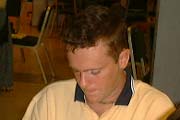| 18th European Youth Team Championships | Page 7 | Bulletin 3 - Wednesday, 10 July 2002 |
|
|
||
|
Round 4 - Sweden vs Czech Republic By Peter Gill The highlight of this match was that, although it was originally
scored as a 16-14 win to the Czech Republic, on the following day
the Swedish team told the Czechs that Board 15 had been scored wrongly,
and that the score for the match should be corrected to a 17-13
win to Czech Republic. This good sportsmanship by the Swedish team
is typical of junior events, and bodes well for the future of bridge.
Although it failed to reach 6NT, this was one of the better auctions. Anyone can bid to 6NT when opener has 12 points and responder has 21 points, but 18 opposite 15 is difficult for standard bidding systems. The final contracts at the 20 tables were: 6NT making 10 times, 6©-1 once, 6¨-1 three times, 6¨-2 four times, 6¨-4 (not played perfectly) once and 3NT once.
The South hand does seem better suited to no-trumps than minor suits, having many points in the doubletons and a lack of texture (e.g. tens and nines) in the minor suits. This factor turns out to be crucial on the actual hand. Most weak no-trump players decided to re-bid 2§ instead of 1NT. On the other hand, the 1NT re-bid both protects ªK and defines the strength of the hand accurately. In the Czech auction above, perhaps North could have chosen 6NT, because the jump to 3NT means that the assets are adequate, the club QJ10 look good for no-trumps and the lack of the diamond J10 is a risk in 6¨. I once read an article that gave a detailed explanation of the choice between no-trumps and a suit contract. It said in part to choose the suit contract if you have most of the QJ10 of the suit, and to choose no-trumps if you lack those cards (and to a lesser extent the nine and the king). Similarly, if you're unsure whether to overcall your five card suit or not, do overcall if you have most of the QJ10, and don't overcall if you lack them. I have found it to be good advice. Successful auctions, omitting the 6NT bashers, included:
Playing Polish Club, 1¨ was limited to a maximum of 16 HCP. 2§ was an artificial relay with many possible hand types. 2© was any maximum, 3© and 3NT were natural, 4NT asked and 5ª showed two aces and one king. Responder thus obtained the information necessary to place the contract accurately.
Simple. Check for heart support, then play 6NT with a minimum of 33 HCP and no suit worth playing in.
2¨ was an artificial enquiry, the rest basically natural and sensible.
Those who re-bid 2§ Returning to the Open Room:
South for Sweden was promptly dealt a series of difficult hands,
not exactly what one would like after having an unfortunate result
on Board 6. Board 7 involved stopping delicately in 5S which made
five, and Board 8 was a bidding puzzle:
1NT showed 14-16 HCP. Many good players deduct a point for featureless 4333 shapes. Double showed a one-suiter, playing DONT. Watching Kjell Ericsson, I thought he did well when the bidding tray emerged from the other side of the screen after 4©, not with the routine Pass from partner, but with 4S. What could it be? A cue-bid, agreeing hearts? How could partner make a slam try when he has no top heart honours? Could 4ª be natural? 1NT was allowed to have a five card major. Could partner perhaps have six spades? Kjell bided his time with a 5§ cue-bid, then boldly jumped to 6ª after partner's co-operative 5¨ cue-bid. There was some delay on the other side of the screen; presumably North, having cue-bid 4ª, was somewhat surprised by the turn of events where he seems to have intended 4ª as a cue-bid but happened to have good spades, and he may have had some difficulty explaining the auction to his screen-mate East. Daniel Sivelind ruffed §A lead, crossed to ¨A, ruffed a club, then ¨K, a third club ruffed high, three rounds of trumps then hearts, making six when hearts didn't break. 11 IMPs to Sweden, making up for Board 6. I did report that this match was competitive. East, whose screen-mate had earlier called the Director about a hesitation, called the Director to check whether everything was OK. After all, had he led a heart, then after ruffing the three club losers in dummy declarer has to exit a diamond in order to get back to hand to draw trumps, allowing West to ruff the third round of diamonds in order to give East a heart ruff, so 6ª might fail on a different lead amongst other things. As in the previous Director call, the Directors determined that there was no problem. In another match, the English declarer in the same contract elected
to ruff only two clubs, surviving if spades are 4-1 or if hearts
are 4-1 onside. When this failed, his Italian opponents scrambled
6 VPs from a match which would have been very one-sided had 6ª made. Returning to the Closed Room:
I know many players who with the West cards would jump in hearts without noticing that the suitable vulnerability and good diamond pips make defending 1¨ Doubled very attractive.
On Vu-Graph, both East/West pairs don't play DONT. The Spanish East passed over 1NT. South for Norway replied 2§ to 1NT, 2¨ from West, a greedy Double by North, rescued to 2© by South (making 4© unreachable for East/West), converted to 2ª by North, down one. The Spanish North at the other table opened 1¨, East doubled, South called 1ª and West 4©. Stian Sundklakk for Norway ducked ªK lead, won the spade continuation in dummy and led a diamond to the king and ace. He ruffed the next spade, and played a heart to the jack followed by ©A felling the king. When a diamond was led from dummy, South fell from grace by ruffing, allowing declarer to make 4© easily. Had South discarded, Barry Rigal points out that West would have won ¨Q and drawn the last trump. North must retain all his diamonds, so must pitch a club. Now a club to the ace and a club ruff reduces North to just diamonds. The ¨3 exit completes the endplay, so 4© will make anyway. |
|||||||||||||||||||||||||||||||||||||||||||||||||||||||||||||||||||||||||||||||||||||||||||||||||||||||||||||||||||||||||||||||||||||||||||||||||||||||||||||||||||||||||||||||||||||||||||||||||||||||||||||||||||||||||||||||||||||||||||||||||||||||||
|
|
| Page 7 |



